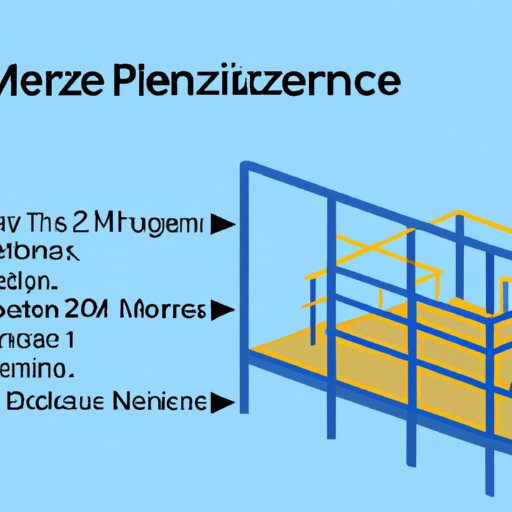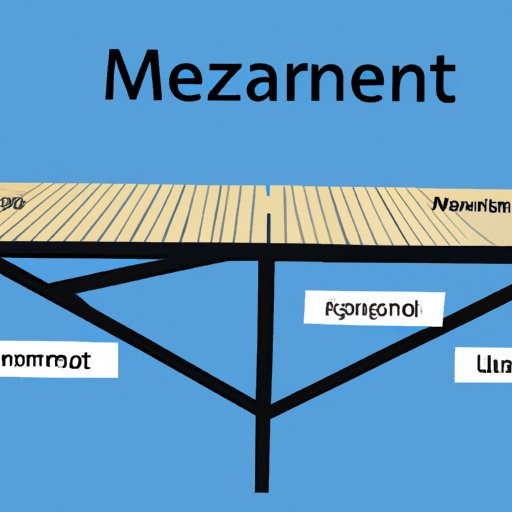Introduction
Mezzanine financing is a type of loan that combines elements of both debt and equity financing. It is typically used by companies that need additional capital but do not want to take on more debt or give up control of their business. In this article, we will explore what mezzanine financing is, the different types of mezzanine financing available, the advantages and risks associated with it, who should consider it, and how to structure a mezzanine financing deal.

Explaining Mezzanine Financing: A Guide to Understanding the Basics
Mezzanine financing is a form of loan that combines elements of both debt and equity financing. It is a hybrid form of financing that allows companies to raise capital without giving up control or ownership of the business. Mezzanine financing is often used by companies that are too large for venture capital investment but not yet large enough to qualify for traditional bank loans.
Mezzanine financing is provided by a lender such as a private equity firm or a hedge fund. The lender provides capital in exchange for a stake in the company, usually in the form of convertible debt or preferred stock. The lender receives a return on its investment in the form of interest payments and/or a share of the profits.
Types of Mezzanine Financing
Mezzanine financing can be structured in several different ways, depending on the needs of the borrower. Some of the most common types of mezzanine financing include:
- Convertible debt: This type of mezzanine financing involves issuing bonds that can be converted into equity at some point in the future.
- Equity participation: This type of mezzanine financing involves the lender taking an equity stake in the company in exchange for providing capital.
- Preferred stock: This type of mezzanine financing involves the issuance of preferred stock, which gives the lender certain rights and privileges over common stockholders.
- Subordinated debt: This type of mezzanine financing involves the issuance of debt that is subordinated to other creditors in the event of a bankruptcy.
Advantages of Mezzanine Financing
Mezzanine financing has several advantages for borrowers. For example, it can provide access to capital without the need to dilute existing shareholders’ equity. It also allows companies to retain control of their business, since the lender does not have voting rights or board representation. Furthermore, mezzanine financing can provide flexibility in terms of repayment, since it is typically structured as a series of interest payments rather than a lump sum.
In addition, mezzanine financing can be used to bridge the gap between equity and debt financing. According to a study conducted by the European Investment Bank, “Mezzanine financing enables companies to fill the funding gap between equity and senior debt financing, allowing them to finance expansion plans, acquisitions and restructuring activities.”
An Overview of Mezzanine Financing: What is it and How Does it Work?
Mezzanine financing is typically structured in three stages: negotiation, documentation, and closing. During the negotiation stage, the borrower and lender negotiate the terms of the loan, including the amount of capital to be provided, the interest rate, and any other conditions of the loan. During the documentation stage, the borrower and lender draw up documents outlining the terms of the loan. Finally, during the closing stage, the documents are signed and the funds are transferred.
When structuring a mezzanine financing deal, there are several important terms and conditions to consider. These include the length of the loan, the interest rate, and the repayment schedule. Other terms and conditions may include the right of the lender to convert the loan into equity, the right to appoint a representative to the company’s board of directors, and the right to receive a share of the profits.
The Benefits and Risks of Mezzanine Financing
Benefits of Mezzanine Financing
Mezzanine financing offers several advantages for borrowers. As mentioned previously, it can provide access to capital without the need to give up control or ownership of the business. It can also provide greater flexibility in terms of repayment, since it is typically structured as a series of interest payments rather than a lump sum. Additionally, mezzanine financing can provide access to capital when traditional bank loans are not available.
Risks of Mezzanine Financing
While mezzanine financing can provide access to capital, it also carries certain risks. For example, if the company fails to make its payments on time, the lender may have the right to convert the loan into equity, resulting in a loss of control for the borrower. Additionally, if the company goes bankrupt, the lender may not be able to recoup its investment. Furthermore, mezzanine financing is typically more expensive than traditional bank loans, making it difficult for some companies to afford.
Who Should Consider Mezzanine Financing?
Companies That Can Benefit from Mezzanine Financing
Mezzanine financing can be beneficial for companies that are too large for venture capital investment but not yet large enough to qualify for traditional bank loans. These companies often need to raise capital quickly and may not have the resources to obtain a loan from a bank. Mezzanine financing can also be beneficial for companies that need additional capital to fund expansion plans, acquisitions, or restructuring activities.
Potential Drawbacks of Mezzanine Financing
Although mezzanine financing can be beneficial for certain companies, it can also present certain drawbacks. For example, mezzanine financing is typically more expensive than traditional bank loans, so companies may need to weigh the costs and benefits before deciding if it is the best option for them. Additionally, mezzanine financing requires companies to give up some degree of control, since the lender will typically have certain rights and privileges over common stockholders.

Comparing Mezzanine Financing Against Traditional Bank Loans
Advantages of Mezzanine Financing Over Bank Loans
Mezzanine financing has several advantages over traditional bank loans. For example, it can provide access to capital without the need to give up control or ownership of the business. Additionally, mezzanine financing can provide greater flexibility in terms of repayment, since it is typically structured as a series of interest payments rather than a lump sum. Finally, mezzanine financing can provide access to capital when traditional bank loans are not available.
Disadvantages of Mezzanine Financing Compared to Bank Loans
Mezzanine financing also has several disadvantages compared to traditional bank loans. For example, it is typically more expensive than traditional bank loans, so companies may need to weigh the costs and benefits before deciding if it is the best option for them. Additionally, mezzanine financing requires companies to give up some degree of control, since the lender will typically have certain rights and privileges over common stockholders.

How to Structure a Mezzanine Financing Deal
Steps Involved in Structuring a Mezzanine Financing Deal
Structuring a mezzanine financing deal involves several steps. First, the borrower and lender need to negotiate the terms of the loan, including the amount of capital to be provided, the interest rate, and any other conditions of the loan. Next, the borrower and lender must draw up documents outlining the terms of the loan. Finally, the documents must be signed and the funds must be transferred.
Negotiating the Terms of the Deal
Negotiating the terms of the deal is an important step in structuring a mezzanine financing deal. The borrower and lender should negotiate the amount of capital to be provided, the interest rate, and any other conditions of the loan. It is important to ensure that the terms of the loan are fair and reasonable for both parties.
Conclusion
Mezzanine financing is a type of loan that combines elements of both debt and equity financing. It is typically used by companies that need additional capital but do not want to take on more debt or give up control of their business. Mezzanine financing can provide access to capital without the need to give up control or ownership of the business, and it can provide greater flexibility in terms of repayment. However, it is typically more expensive than traditional bank loans, and it requires companies to give up some degree of control. Ultimately, companies should carefully consider the costs and benefits of mezzanine financing before deciding if it is the best option for them.
Summary of Mezzanine Financing
Mezzanine financing is a type of loan that combines elements of both debt and equity financing. It is typically used by companies that need additional capital but do not want to take on more debt or give up control of their business. Mezzanine financing can provide access to capital without the need to give up control or ownership of the business, and it can provide greater flexibility in terms of repayment. However, it is typically more expensive than traditional bank loans, and it requires companies to give up some degree of control.
Final Thoughts on Mezzanine Financing
Mezzanine financing can be a valuable source of capital for companies that need access to funds quickly. It can provide access to capital without the need to give up control or ownership of the business, and it can provide greater flexibility in terms of repayment. However, it is important to consider the costs and benefits of mezzanine financing before deciding if it is the best option for your company.
(Note: Is this article not meeting your expectations? Do you have knowledge or insights to share? Unlock new opportunities and expand your reach by joining our authors team. Click Registration to join us and share your expertise with our readers.)
